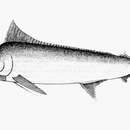Diagnostic Description
provided by Fishbase
Body elongate and not very compressed; upper jaw produced into a robust but not very long beak; two dorsal fins, the height of the first less then the greatest body depth, becoming shorter posteriorly; pectoral fins falcate and rigid, with 19 to 20 rays; body densely covered with small, embedded scales with 1 or 2 sharp points; back dark blue; belly silvery white; membrane of first dorsal fin blue black, without spots; flanks without spots (Ref. 55763). Dark blue above, silvery white below; sometimes with light blue vertical stripes; 1st dorsal fin blackish to dark blue, other fins dark brown with tinges of dark blue in some specimens.
- Recorder
- Cristina V. Garilao
Life Cycle
provided by Fishbase
Believed to prefer water temperatures around 27° to 28°C during spawning. Egg counts of ripe roe totaled about 40 million per female.
Migration
provided by Fishbase
Oceanodromous. Migrating within oceans typically between spawning and different feeding areas, as tunas do. Migrations should be cyclical and predictable and cover more than 100 km.
Morphology
provided by Fishbase
Dorsal spines (total): 0; Dorsal soft rays (total): 39 - 50; Analspines: 0; Analsoft rays: 16 - 21
- Recorder
- Cristina V. Garilao
Trophic Strategy
provided by Fishbase
Seasonal changes in distributions of catch rates, reflecting concentrations of fish, do take place but individuals do not follow clear migration routes (Ref. 30358). Such seasonal concentrations are known to occur in the north-west Coral Sea, off the North West Shelf of Australia, in the Banda Sea and the east China Sea (Ref. 6390). There have been suggestions that the distributions and migrations of black marlin are sex-dependent (Ref. 30359). Knowledge of seasonal changes in distribution and migration patterns of this highly mobile species is largely based on catch data collected by the Japanese longline fleet (Ref. 6390). Tagging has also assisted greatly in interpretation of movement patterns (Ref. 30358, 30360).In Australian waters, aggregation in the Coral Sea during September-December, presumed 1-2-year-old fish and 1 or 2 older groups move south parallel to the eastern Australian coastline from north Queensland to central New South Wales, apparently in association with the southward movement of the East Australian Current (Ref. 30358). By April, however, the fish have probably dispersed eastwards (catch rates in eastern Australia between April and August are generally very low). Fish can move large distances (up to 7200 km in 359 days) and recaptures from tagging studies over several years strongly suggest annual homing of at least part of the (western Coral Sea) population (Ref. 30358). It appears that fish also migrate from northwestern Australia to Indian Ocean waters south of Indonesia in late March-April, and fish migrate back to north-western Australia during October (Ref. 30354). High catch rates occur in the Banda Sea north of Australia between January and April (Ref. 6390).Black marlin larvae have been found only in the north-west Coral Sea off Queensland and off northwestern Australia, south of 10°S (where they were misidentified as sailfish larvaeIstiophorus platypterus (Ref. 30361, 30362). Off Lizard Island in north Queensland, concentrations of black marlin larvae have been found in close proximity (within half a mile) to the outer slopes of coral reefs on the edge of the continental shelf (Ref. 30362).
Biology
provided by Fishbase
Oceanic, usually found in surface waters above the thermocline, often near shore close to land masses, islands and coral reefs. Feed on fishes, squids, cuttlefishes, octopods, large decapod crustaceans and mostly on small tunas when abundant (Ref. 9668). The flesh is of good quality; marketed refrigerated or frozen and prepared as sashimi in Japan (Ref. 9308). Also Ref. 9692.
Importance
provided by Fishbase
fisheries: commercial; gamefish: yes

